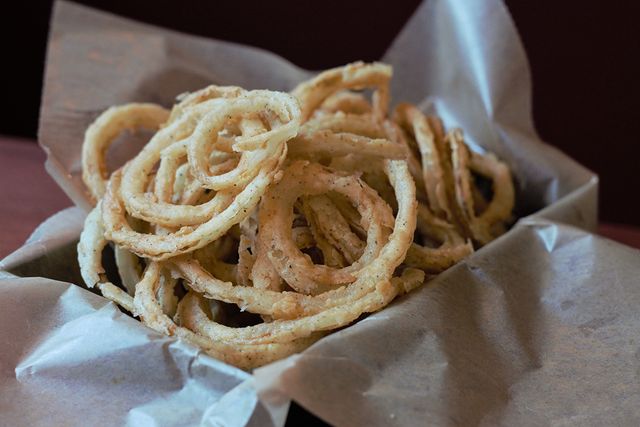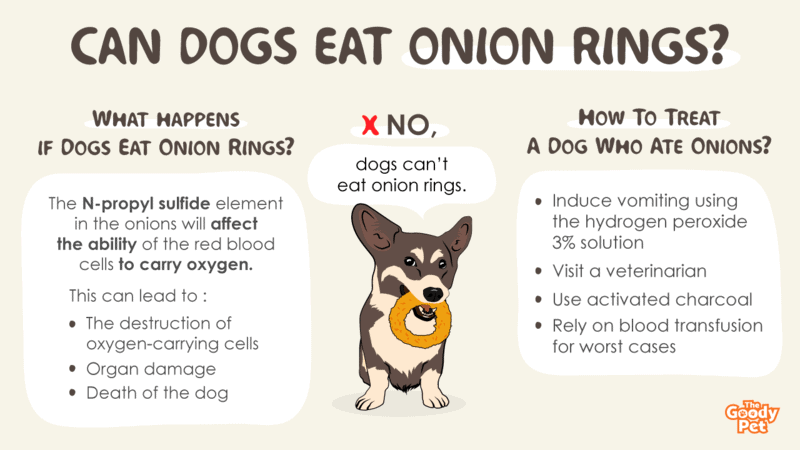As a common substitute for French fries, onion rings certainly make a favorite treat for many. But one thing most onion-loving dog owners don’t know is whether or not this appetizer is safe for their furry companions. So, can dogs eat onion rings?
No, dogs can’t eat onion rings. Onion rings contain N-propyl disulfide, a toxin that attacks red blood cells in dogs, increasing their chances of developing hemolytic anemia. As such, we recommend that you avoid feeding dogs onion rings.
With so much lined up for you here, today should be the long-awaited day that brings answers to all your queries about dogs eating onion rings. But that’s going to take a bit of your patience, so keep reading to the end.
Are Onion Rings OK For Dogs?

No, onion rings aren’t okay for dogs. The N-propyl disulfide compound is a dangerous poison for dogs. And again, the fact that onion rings come fried all again disqualifies them from the list of things your dog can safely eat. So yes, don’t even think about sharing this appetizer with your lovely canine.
Onions belong to the Allium family. Just in case you need to know more, it’s the same family carrying the likes of garlic, leeks, scallions, shallots, and so much more. And if you were keen enough on my examples, you will agree with me that they all go a long way to improve the flavor of our foods. Nevertheless, they all remain a no-do treat for dogs! So sad!
You see, members of the same family have at least a thing in common. Precisely, members of the Allium group all have N-propyl disulfide, a compound not harmful to humans, but it’s a deadly poison for dogs.
When dogs eat onion rings or any other food or treat containing N-propyl disulfide, they are likely to develop issues from it. The blood, in this case, is the main target of the toxin. After it gets into the body, N-propyl disulfide will attack the red blood cells.
Before we talk more about the toxin and its effects on the red blood cells, little knowledge on blood should help. Blood plays a central role in ensuring that everything runs well in the body. That opaque red fluid spreads “life” to all body organs.
What that means is, anything that affects blood functions opens the way for a series of health complications. We will be going there later on in the article. But first, let’s see whether a small amount of onion rings is indeed a ‘big amount’ for pups.
Will One Onion Ring Hurt My Dog?
No, an onion ring is unlikely to hurt your dog. Sure, that single ring still has the N-propyl disulfide compound, but it just doesn’t come in levels adequate to stir up trouble for a dog. But again, whether or not an onion ring can cause harm much depends on the dog.
As much as N-propyl disulfide is toxic to dogs, its mere presence in a dog’s body system doesn’t guarantee something negative. Your dog still has some internal mechanisms to fight back toxins like those in onion rings. So yes, a small amount of this compound may not be “strong” enough to cause anything negative in dogs.
But as we’ve said, all fear isn’t for N-propyl disulfide. The preparation method also matters a lot. Usually coming fried, which is never a healthy way to prepare anything for canines, it will take much less of this crispy treat than it otherwise could to cause dogs trouble.
In addition, before giving your dog an onion ring, it’s worth knowing that each dog is unique in its own way. You might have encountered videos on Youtube of some dog owners offering their canines this treat, but that shouldn’t fool you.
The fact that it doesn’t cause any harm to their dog doesn’t mean that things will take the same route for you and your canine. A simple tip to help avoid trouble – always view your dog as unique from any other.
Perhaps your dog is allergic to onions. If that turns out to be the case, even the smallest amount could cause severe consequences for them. In other words, what I’m trying to emphasize is that dogs shouldn’t eat even a single piece of this treat.
What Happens If A Dog Eats Onion Rings?

What happens if a dog eats onion rings is that the N-propyl sulfide element in the onions will affect the ability of the red blood cells to carry oxygen. That could lead to the death of these oxygen-carrying cells, organ damage, and sometimes death!
We began by saying that blood is the fluid that takes life to all body organs. It does that by ensuring a constant supply of all the necessities for their survival – oxygen, nutrients, and much more.
When a dog eats onion rings, the n-propyl sulfide toxin invades the red blood cells. Then, it attacks oxygen-transporting protein molecules called hemoglobin. You can think of hemoglobin as “vehicles” that transport oxygen.
When this attack happens, the toxin affects the hemoglobin-oxygen affinity, which basically is the ability of the two (hemoglobin and oxygen) to bond. That results in a low oxygen supply to all parts of the canine’s body.
When your dog’s body cells don’t get enough oxygen, they can die of the carbon they release. That’s where the issue of organ failure comes in. The organs likely to stop first include the brain, kidneys, heart, liver, lungs, and other vital organs.
But that’s not all – when the dog’s immunity cells detect that RBCs are “hosting” something dangerous, it resolves to fight the invader together with its “host” – its very own RBCs. That results in the decrease of the red blood cell count, a condition we now refer to as hemolytic anemia.
How Do I Know If My Dog Has Onion Poisoning?
You can know that your dog has onion poisoning when they exhibit signs of this kind of toxicity. When you notice any of the behavioral changes, contact a certified vet immediately. The vet will guide you to manage the condition and keep things from worsening.
Signs of onion poisoning in dogs include but are not limited to;
- Lethargy
- Difficult breathing
- Decreased appetite
- Blood in urine
- Panting
- Diarrhea
- Vomiting
- Increased heart rate
- Pale gums
In the case of ingestion, you should notice at least one of these signs. But again, if your dog doesn’t exhibit any of the above, it doesn’t rule out poisoning. Perhaps the amount of onion rings the dog ate isn’t large enough to cause them issues.
Usually, toxicity will require 0.5% of your dog’s body weight in onions. That’s just less than an ounce of onions for every 10 pounds of your dog’s body weight! But as we’ve earlier said, you have a unique dog.
Where you aren’t sure that your dog ate onion rings but have a few things that suggest possible ingestion, it’s again wise you chat with a qualified veterinarian. You don’t know what will come out of it, so it’s always best to play it safe.
Can Onion Rings Cause Seizures In Dogs?
Yes, onion rings can cause seizures in dogs.
Onion rings have thiosulfate, a compound that’s commonly known to cause seizures in pups. So yes, seizures are another sign that your dog could be having onion poisoning.
Seizures are more often inherited. In other words, dogs with seizures can pass it down to their offspring, who pass it to their offspring, and so on. However, most of the time, you won’t notice this disorder until the dog attains some age.
But dogs can also develop seizures from other causes. For instance, they can get it when they eat some toxins. And yes, the thiosulfate compound found in onions is among the list of toxins that can give dogs seizures.
So yes, when you notice that your dog has seizure issues, the finger doesn’t have to always point at the breeder – perhaps your dog ate onion rings or some other food containing toxins likely to trigger the condition.
How Long After Eating Onion Rings Will A Dog Get Sick?
How long after eating onion rings a dog will get sick will depend on the toxicity level. High levels of toxins in the body will make your dog sick faster. However, sickness usually manifests 24 hours from the time of ingestion.
After dogs eat onion rings, they usually won’t get sick immediately. It will take time before the toxin in onion rings wins the fight against the dog’s immune cells. That’s where the issue of quantity comes in. More toxins take less time to overpower the immune cells, so signs won’t take long to manifest. Symptoms are a sign that the toxin part is winning.
Small and immunocompromised dogs are more likely to get sick faster than mature (not senior dogs) and healthy pups.
That’s because their bodies aren’t strong enough to fight back the toxins effectively. So yes, sometimes it will take minutes or a few hours before your dog becomes sick after eating onion rings.
Gastroenteritis is most of the time the first sign of sickness after dogs eat onion rings. It comes along with diarrhea and vomiting. With time, diarrhea and vomiting dehydrate the affected dog, which causes more complications. In other words, it’s more of a series of happenings.
The first sign is noticeable within 24 hours after ingesting onion rings. However, the sickness could take as long as a week before it manifests. That’s why you need to observe your dog closely for a week or so after they eat onion rings.

How Long Does Onion Poisoning Last In Dogs?
How long onion poisoning lasts in dogs depends on the severity of the condition. Dogs experiencing severe signs take much more time to recuperate than those showing mild symptoms.
In other words, there isn’t a definite answer to the time it takes for dogs to recover from onion poisoning. The more the symptoms grow milder, the more your dog draws closer to its complete recovery.
Dogs with weaker immunity or sensitive bodies may take more time before they can eventually regain their health and happiness. But the good news is that onion poisoning will most of the time not cause death with prompt medical care.
How Do You Treat A Dog Who Ate Onions?
You can treat a dog that ate onions by finding a way to eliminate the toxins from its body. Where ingestion happened within the past four hours, you can induce vomiting. As they throw up, they will remove any toxin pending absorption.
The hydrogen peroxide 3% solution will come in handy here. A teaspoon for every five lbs of your dog’s body weight should cause vomiting in as little time as 15 minutes. But beware, dogs weighing more than 45 lbs need not exceed three tablespoons of this solution.
Where ingestion happened more than four hours ago, the only option you have is to visit a veterinarian. Most of the toxins at this time are already in the bloodstream, so vomiting may not be of much essence.
The vet will perform an assessment which more often includes blood tests to figure out the extremity of things. From there, they can adopt the treatment measures they deem appropriate based on their professional judgment.
Sometimes the dog doctor may offer an injection to help induce vomiting. What happens when they suspect some unabsorbed traces of onions. Then, the doctor will usually prescribe activated charcoal to help prevent leftover traces.
In the event of damage to the red blood cells, blood transfusion becomes necessary. The vet will definitely do much more, but transfusion will most of the time be among the things that come first.






